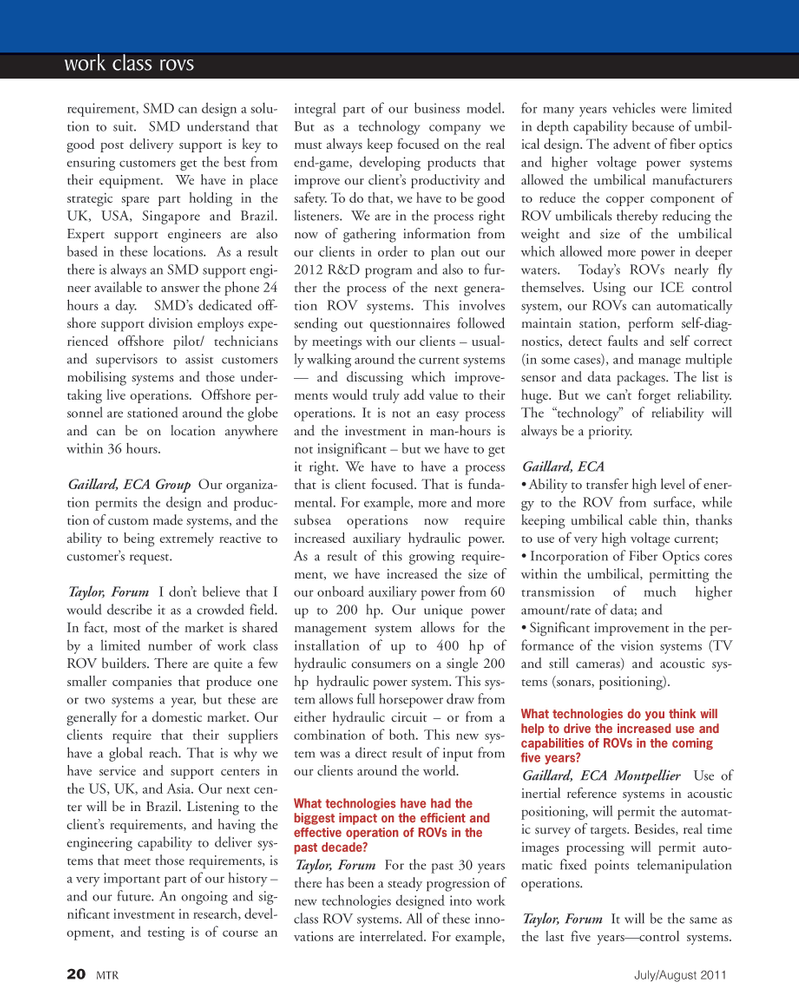
Page 20: of Marine Technology Magazine (July 2011)
MTR100 Edition
Read this page in Pdf, Flash or Html5 edition of July 2011 Marine Technology Magazine
requirement, SMD can design a solu- tion to suit. SMD understand that good post delivery support is key to ensuring customers get the best from their equipment. We have in place strategic spare part holding in the UK, USA, Singapore and Brazil. Expert support engineers are also based in these locations. As a result there is always an SMD support engi- neer available to answer the phone 24 hours a day. SMDs dedicated off- shore support division employs expe- rienced offshore pilot/ technicians and supervisors to assist customers mobilising systems and those under-taking live operations. Offshore per- sonnel are stationed around the globe and can be on location anywhere within 36 hours. Gaillard, ECA Group Our organiza- tion permits the design and produc- tion of custom made systems, and theability to being extremely reactive to customers request. Taylor, Forum I dont believe that I would describe it as a crowded field. In fact, most of the market is shared by a limited number of work class ROV builders. There are quite a few smaller companies that produce one or two systems a year, but these are generally for a domestic market. Our clients require that their suppliers have a global reach. That is why we have service and support centers in the US, UK, and Asia. Our next cen- ter will be in Brazil. Listening to the clients requirements, and having the engineering capability to deliver sys- tems that meet those requirements, is a very important part of our history ? and our future. An ongoing and sig- nificant investment in research, devel- opment, and testing is of course anintegral part of our business model. But as a technology company we must always keep focused on the real end-game, developing products that improve our clients productivity and safety. To do that, we have to be good listeners. We are in the process right now of gathering information from our clients in order to plan out our 2012 R&D program and also to fur- ther the process of the next genera- tion ROV systems. This involves sending out questionnaires followed by meetings with our clients ? usual- ly walking around the current systems ? and discussing which improve- ments would truly add value to their operations. It is not an easy process and the investment in man-hours is not insignificant ? but we have to get it right. We have to have a process that is client focused. That is funda- mental. For example, more and more subsea operations now require increased auxiliary hydraulic power. As a result of this growing require- ment, we have increased the size of our onboard auxiliary power from 60 up to 200 hp. Our unique power management system allows for the installation of up to 400 hp ofhydraulic consumers on a single 200 hp hydraulic power system. This sys- tem allows full horsepower draw from either hydraulic circuit ? or from a combination of both. This new sys- tem was a direct result of input from our clients around the world. What technologies have had thebiggest impact on the efficient and effective operation of ROVs in the past decade?Taylor, Forum For the past 30 years there has been a steady progression of new technologies designed into work class ROV systems. All of these inno- vations are interrelated. For example, for many years vehicles were limited in depth capability because of umbil-ical design. The advent of fiber optics and higher voltage power systems allowed the umbilical manufacturers to reduce the copper component of ROV umbilicals thereby reducing the weight and size of the umbilical which allowed more power in deeper waters. Todays ROVs nearly fly themselves. Using our ICE control system, our ROVs can automatically maintain station, perform self-diag- nostics, detect faults and self correct (in some cases), and manage multiplesensor and data packages. The list is huge. But we cant forget reliability. The technology? of reliability will always be a priority. Gaillard, ECA ? Ability to transfer high level of ener- gy to the ROV from surface, while keeping umbilical cable thin, thanksto use of very high voltage current; ? Incorporation of Fiber Optics cores within the umbilical, permitting thetransmission of much higheramount/rate of data; and ? Significant improvement in the per- formance of the vision systems (TV and still cameras) and acoustic sys-tems (sonars, positioning).What technologies do you think willhelp to drive the increased use and capabilities of ROVs in the comingfive years?Gaillard, ECA Montpellier Use of inertial reference systems in acoustic positioning, will permit the automat-ic survey of targets. Besides, real time images processing will permit auto- matic fixed points telemanipulation operations.Taylor, Forum It will be the same as the last five years?control systems. 20MTRJuly/August2011 work class rovs

 19
19

 21
21
